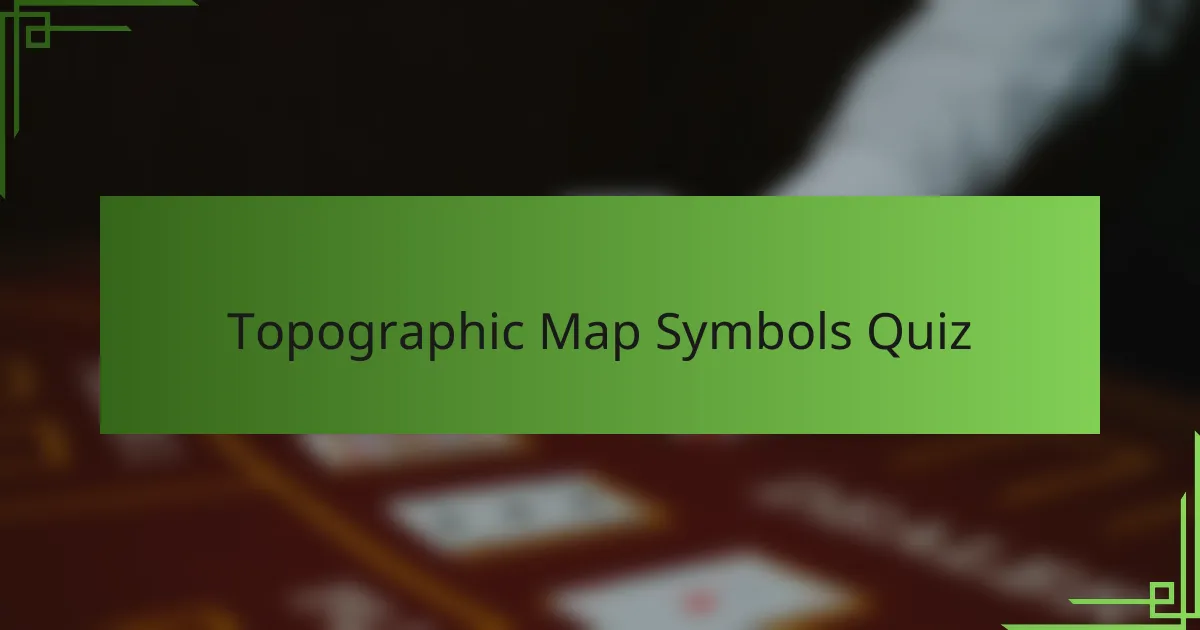
Topographic Map Symbols Quiz
1. What symbol on a topographic map typically represents a forested area?
- Brown elevation ticks
- Green shading or tree symbols
- Black dashed lines
- Blue contour lines
2. On a topographic map, what does a series of closely spaced contour lines indicate about the terrain?
- Areas with dense forest cover
- Steep terrain with rapid elevation change
- Water bodies like lakes or rivers
- Flat terrain with minimal elevation change
3. Which symbol on a topographic map is used to depict a river or stream?
- Brown concentric circles
- Black dashed lines
- Red solid lines
- Blue wavy or curving lines
4. How is a trail or footpath usually represented on a topographic map?
- Dotted line
- Solid line
- Dashed line
- Thick solid line
5. What does a blue line with hachures represent on a topographic map?
- A contour line marking the highest elevation point
- A boundary line for a protected watershed area
- A permanent river or stream flowing downhill
- A depression or hollow in the terrain with water flow indicated
6. Which topographic map symbol denotes a built-up urban area?
- Green diagonal stripes
- Blue dashed lines
- Brown contour lines
- Grey shading or solid gray area
7. What shape or symbol commonly represents a mountain peak on a topographic map?
- Dashed lines indicating trails
- Green shaded areas signifying forests
- Blue lines representing rivers
- Contour lines forming concentric circles with a peak symbol
8. How can you recognize a depression or basin on a topographic map?
- Contour lines that are straight and parallel over a large area
- Closed contour lines with hachure marks pointing inward
- Widely spaced contour lines indicating a steep uphill slope
- Contour lines forming concentric circles with increasing elevation values inside
9. What does a dashed line usually signify on most topographic maps?
- A political boundary
- A trail or footpath
- A river or stream
- A geological fault line
10. Which color is typically used to represent water bodies on a topographic map?
- Blue
- Green
- Yellow
- Brown
11. How is a railroad track commonly indicated on a topographic map?
- A double line with shaded fill between them
- A dashed line with dots on either side
- A thick solid black line with small triangles along it
- A line with cross-ties perpendicular to the track line
12. What symbol is used to indicate a power transmission line on a topographic map?
- A line with small circles or insulators along it
- A dashed line with crosshatches at regular intervals
- A wavy line accompanied by small dots
- A solid line with triangles pointing in one direction
13. How are elevation benchmarks marked on a topographic map?
- By shading the area around the elevation point in blue
- By using a large circle around the elevation number
- With a small triangle and an elevation number
- With contour lines only, without additional symbols
14. Which symbol represents a [censured] or place of worship on a topographic map?
- A circle with a crosshair (+)
- A triangle symbol ()
- A small cross symbol (†)
- A square with a dot inside (·)
15. What does a black `X` represent on a topographic map?
- The peak of a mountain or hill
- A surveyed benchmark indicating an exact elevation
- A trail junction or intersection point
- A designated campsite location

Congratulations on Completing the Topographic Map Symbols Quiz!
Well done on finishing the quiz focused on topographic map symbols. You have taken an important step in understanding how these symbols represent real-world features on a map. This knowledge is essential for interpreting geographic information accurately. By recognizing symbols for elevations, water bodies, vegetation, and man-made structures, you improve your ability to read and use maps effectively.
Throughout the quiz, you likely enhanced your spatial awareness and gained insight into how topographic maps communicate complex landscapes simply and clearly. These skills are valuable not only for geography enthusiasts but also for outdoor adventurers, planners, and educators. Understanding map symbols strengthens your overall navigation skills and deepens your appreciation of the physical world.
To build on what you have learned, we invite you to explore the next section on this page. It offers detailed explanations and examples of topographic map symbols that will expand your knowledge further. Delve into this resource to become more confident and skilled in interpreting maps, enriching your study of geography.

Topographic Map Symbols
Definition and Purpose of Topographic Map Symbols
Topographic map symbols are standardized icons and markings used on topographic maps to represent natural and man-made features of the Earth’s surface. These symbols provide essential information about terrain shapes, elevations, water bodies, vegetation, infrastructure, and cultural landmarks. The United States Geological Survey (USGS) and the Ordnance Survey in the UK are key authorities that have developed and maintained comprehensive symbol sets. Understanding these symbols is critical for geographers, hikers, engineers, and environmental scientists to accurately interpret the detailed spatial information conveyed by topographic maps.
Common Natural Features Represented by Topographic Map Symbols
Topographic map symbols frequently represent natural features such as contour lines indicating elevation changes, rivers and streams shown by blue lines, and vegetation types like forests or orchards marked with specific green patterns. For example, contour lines on USGS maps connect points of equal elevation, enabling users to visualize slopes and relief. Lakes and wetlands use standardized blue shading or symbols, while landforms like cliffs or sand dunes have distinct graphical representations. These symbols enable precise geographic analysis of terrain structure and natural resource distribution.
Man-Made Structures and Infrastructure Symbols
Symbols on topographic maps also depict man-made structures including roads, railways, buildings, and utility lines. Roads have different patterns or colors based on their type—such as highways, dirt roads, or trails—according to standards set by mapping authorities like the USGS. Buildings, often shown as black squares or rectangles, represent houses, schools, or commercial buildings. Railways appear as parallel lines with cross ties. Power lines and pipelines are indicated by linear symbols with annotations. These standardized symbols facilitate navigation, planning, and infrastructure management.
Understanding Contour Lines and Elevation Markings
Contour lines are fundamental topographic symbols used to represent elevation and landform shape. Each line connects points at the same elevation, with the vertical distance between lines called the contour interval, usually specified in feet or meters. Closely spaced lines indicate steep terrain, while widely spaced lines indicate gentle slopes. Index contours are bolder lines labeled with elevation numbers to help users identify height quickly. This system is essential in geography for terrain analysis, watershed delineation, and engineering surveys.
Specialized Symbols for Geographic Features and Land Use
Specialized topographic map symbols provide detailed information about specific geographic features such as mines, quarries, boundaries, and recreational facilities. For instance, active mines are marked with pickaxe symbols, while quarries have different patterns. National and state boundaries, park areas, and wildlife refuges use distinct line styles or colors standardized by organizations like the National Geospatial-Intelligence Agency (NGA). Recreational symbols include campsites, viewpoints, and trails, each with unique icons. These symbols support diverse applications in geography, conservation, and land management.
What are topographic map symbols?
Topographic map symbols are graphic representations used on maps to depict natural and man-made features such as mountains, rivers, roads, and buildings. These symbols simplify complex landscapes into recognizable icons, enabling easier reading of terrain and features. The United States Geological Survey (USGS) provides standardized symbols widely used in topographic mapping, ensuring consistency and accurate interpretation across various maps.
How do topographic map symbols represent elevation?
Topographic map symbols represent elevation primarily through contour lines, which connect points of equal elevation. These lines illustrate the shape and steepness of the terrain. Closely spaced contour lines indicate steep slopes, while widely spaced lines indicate gentle slopes. Contour intervals denote the vertical difference between adjacent lines, and benchmark symbols mark exact elevation points, as standardized in USGS topographic maps.
Where are topographic map symbols typically used?
Topographic map symbols are typically used on topographic maps created for geographical analysis, hiking, urban planning, and environmental studies. These maps are produced by government agencies such as the USGS in the United States and Ordnance Survey in the United Kingdom. They provide detailed information about landforms, structures, and features in rural, urban, and wilderness areas.
When were standardized topographic map symbols first developed?
Standardized topographic map symbols were first developed in the late 19th and early 20th centuries as national mapping organizations like the USGS began creating detailed maps. The USGS formalized a set of symbols by the early 1900s, allowing consistent map reading and interpretation nationwide. This development coincided with advances in surveying and printing technologies, improving map accuracy and usability.
Who creates and regulates topographic map symbols?
Topographic map symbols are created and regulated by national and international mapping authorities. In the United States, the United States Geological Survey (USGS) establishes and maintains standards for these symbols. Internationally, organizations like the International Cartographic Association influence symbol standardization. These bodies ensure symbols accurately represent geographic features and maintain uniformity across different map series.
